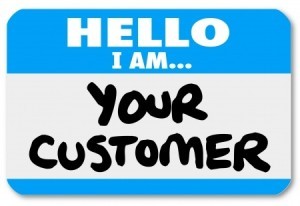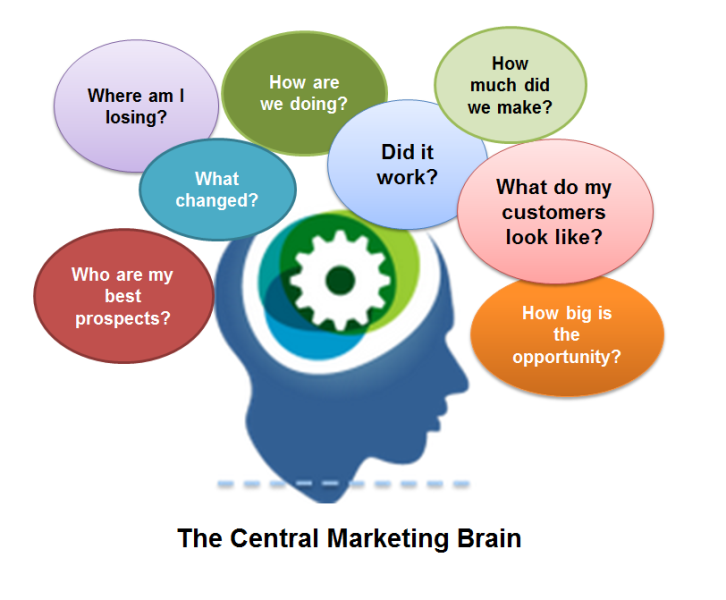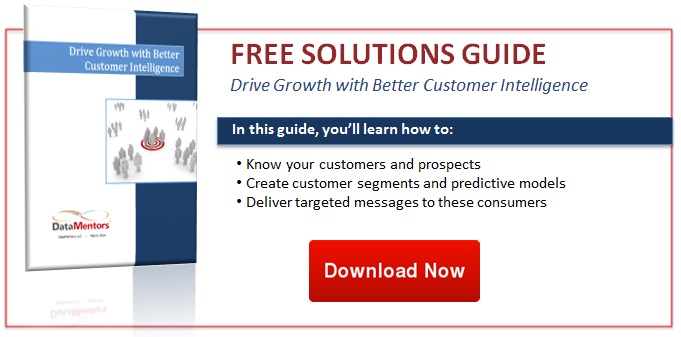We are in what Forrester calls “The Age of the Customer”.
Customers are in the driving seat, not companies. Companies must figure out ways to get to know their customers on a deeper, more personal level. And in an age of bigger and faster data, all sorts of information can be mined to truly get to know your customers.

In fact, consumers are sharing more data than ever before as they browse websites, sign-up for loyalty programs and e-newsletters, post to social media, and download content.
With so much data being created, do you have the right insights to answer the following questions?
- What do my best customers look like and what will keep them loyal?
- Which channels do they use on their path to purchase?
- Who is in the market for my products and services?
- What will drive the best customer experiences?
- What patterns may indicate unhappy customers?
- Which customers can I upsell or cross-sell?
If you can’t answer these questions (and many companies can’t), here’s how you can really get to know your customers.
Key Takeaways:
- Customer-Centric Era: Companies must prioritize understanding customers deeply in what Forrester calls “The Age of the Customer.”
- Data Explosion: With 2.5 million terabytes of data generated daily, businesses have unparalleled access to customer insights.
- Unified Customer Data: Integrating data from various touchpoints into a single repository provides a 360-degree customer view.
- Effective Segmentation: Analyzing customer data into segments based on demographics, behaviors, and attitudes allows targeted marketing strategies.
- Enrich with Third-Party Data: Adding external data enhances customer profiles, enabling more precise targeting.
- Revenue Opportunities: Insights from customer data can lead to better retention, loyalty, upselling, and conversion rates.
Get Your Customer Data in Order
As you know, your customers engage with you across many channels. They are calling customer service, buying products on-line, signing up for loyalty programs, leaving comments on your social media pages, redeeming on-line coupons, clicking through emails, and on and on.
Each of these interactions contains important details. However, it’s only that, little pieces of valuable information here and there. By no means the complete picture on who your customers really are.
And with no way of seeing the complete picture, there is so way to answer all those important questions that will ultimately drive growth for your business.
Each of these customer touchpoints must be integrated into a single repository – a marketing database or warehouse.
Multiple records may exist for the same customer or there may be inaccurate details and missing fields. A data integration and quality solution will ensure that a single, comprehensive record is created – a 360-degree view of each customer.
Analyze Your Customer Data
With an integrated database solution in place, it’s time to put that data to use. Analyze your data for insights into your customer’s behaviors, what they want, what they are doing, and how to strengthen their loyalty.
Not all your customers are the same so you need to focus on customer segments – or smaller groups of customers who share similarities.
Analyzing customer data to create segments allows for targeted messages to specific groups, as well as development of the right marketing mix. Certain customers may prefer email while others respond best to direct mail or text messages. It’s important to know which channels your customers prefer to optimize their experience and create loyal brand advocates.
Consider a variety of factors when segmenting, such as spending patterns, gender, income, location, hobbies, interests, and other key attributes. Segments can be defined by demographics, which is basically who someone is. Another approach is by behavior, which looks at not who they are, but at what they do. For example, did they click through an email based on a coupon or other incentive? Attitudinal segmentation takes this a step further and segments by what they think. What are their perceptions of your products or services or what types of promotions are most enticing?
The best segmentation strategies involve a mix of all these factors.
Let’s look at an example:
- Company: Furniture Store
- Segment: Home Decorating; values high-end products
- Attitudes: Prefers to research online and buy in-store to touch/feel product before buying; also likes new styles and premium fabrics
- Behavior: High-value purchases, high frequency, all purchases made in-store
- Demographics: Suburban, within 20 miles of a retail location, high household income, female, ages 45-55
Add Rich Third-Party Data to the Mix
So the data has been collected and integrated, key customer segments created, but you may still be lacking some of the right data.
Customer records may be missing email addresses or other critical details. Or perhaps as in the case of our furniture retailer, you want to know details such as home square footage, ages of children in the household, or certain lifestyle interests.
Adding additional demographic and firmographic data establishes a more comprehensive customer and prospect profile.
This includes demographic data, such as age, health interests, marital status, net worth, occupation, religious affiliation, and more. Demographic data may include annual revenue, D&B credit rating, legal code, number of employees, primary business address, SIC, and years in business.
Unique and Hard-to-Find Data can also be sourced through Data-as-a-Service (DaaS), which is data that has been aggregated from hundreds of Big Data sources. These data sets are highly targeted and go well beyond third party lists.
This data is sourced from 6 specific categories:
- Web Mining: Data compiled by mining the open web. This includes automated processes of discovering and extracting information from Web documents and servers, including mining unstructured data. This can be information extracted from server logs and browser activity, information extracted about the links and structure of a site, or information extracted from page content and documents.
- Search Information: Data available as a result of browser activity tracking search and intent behavior. This data also identifies digital audiences through onboarding (matching consumers to their online IDs).
- Social Media: The average global Internet user spends two and a half hours daily on social media. A vast array of data is available on personal preferences, likes, “check-ins”, shares, and comments users are making.
- Crowd Sourcing: This is collective intelligence gathered from the public. Data is compiled from multiple sources or large communities of people, including forums, surveys, polls, and other types of user-generated media.
- Transactional: Data that is created when organizations conduct business, and can be financial, logistical or any related process involving activities such as purchases, requests, insurance claims, deposits, withdrawals, flight reservations, credit card purchases, etc.
- Mobile: Mobile data is driving the largest surge in data volume. It isn’t only a function of smartphone penetration and consumer usage patterns. The data is also created by apps or other services working in the background.
The Role of Technology in Customer Data Integration
Effective customer data integration has become a cornerstone for businesses aiming to deliver personalized experiences and drive growth.
Technology plays a pivotal role in streamlining this process, enabling companies to consolidate fragmented customer data from various touchpoints into a unified repository.
Here’s how technology facilitates customer data integration and why it’s indispensable:
1. Centralized Data Repositories
Modern tools like Customer Relationship Management (CRM) systems and data warehouses serve as centralized hubs for collecting and managing customer data. These platforms aggregate information from multiple sources, such as social media, websites, email campaigns, and offline interactions, providing a comprehensive view of customer behavior and preferences.
Key Technologies: Salesforce, HubSpot, Microsoft Dynamics 365
2. Real-Time Data Synchronization
Advanced integration technologies allow businesses to synchronize customer data in real-time. This ensures that all departments—sales, marketing, and customer support—have access to the most up-to-date information, fostering better collaboration and quicker decision-making.
Key Technologies: Zapier, MuleSoft, Apache Kafka
3. AI and Machine Learning for Data Insights
Artificial Intelligence (AI) and Machine Learning (ML) algorithms analyze integrated data to uncover patterns and insights. These technologies can predict customer behavior, segment audiences more effectively, and even recommend personalized offers or communication strategies.
Key Technologies: IBM Watson, Google AI, AWS Machine Learning
4. Data Cleansing and Validation Tools
Customer data is often riddled with inaccuracies, duplicates, or missing fields. Technology solutions automate the process of cleaning and validating data, ensuring that businesses work with accurate and reliable customer records.
Key Technologies: Informatica, Talend, OpenRefine
5. APIs for Seamless Integration
Application Programming Interfaces (APIs) enable seamless integration between different systems and applications. APIs ensure that data flows smoothly across platforms, eliminating silos and creating a unified customer view.
Key Technologies: RESTful APIs, GraphQL, JSON-based APIs
6. Data Security and Compliance
With increasing concerns about data privacy, technology helps businesses stay compliant with regulations like GDPR and CCPA. Encryption, access controls, and audit trails ensure that customer data is secure and used ethically.
Key Technologies: Cloudflare, Okta, OneTrust
7. Customer Data Platforms (CDPs)
CDPs have emerged as essential tools for unifying and activating customer data across channels. These platforms integrate data, resolve customer identities, and enable marketers to deliver consistent, personalized experiences.
Key Technologies: Segment, Tealium
Wrapping Up
With the right data in place and a clear, comprehensive customer view, you can pinpoint any number of hidden revenue opportunities:
- Better align the right offers to the right consumers
- Drive more up-sell and cross-sell opportunities
- Increase customer retention and loyalty
- Convert more prospects into customers
- Maximize customer value
So if you can’t say you really know your customers, isn’t it time to get to know them?
For more great tips on how to get to know your customers better, download our solutions guide: “Drive Growth with Better Customer Intelligence”


